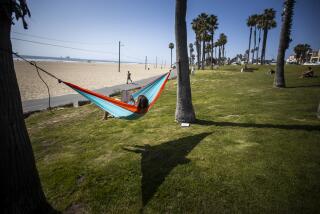For some, it’s the summer of their discontent
- Share via
Summertime evokes images of splashing at the beach, picnics and barbecues, and long, sunshine-filled days. But for a small percentage of people, the onset of summer brings on a wave of dread, depression and listlessness.
Elise Hancock, a 68-year-old retired journalist from Baltimore, began noticing her seasonal depression symptoms around the age of 15, long before they were recognized in the medical literature.
During the summer, Hancock says, her memory falters and her productivity declines. If she spends a day outside in extreme heat, it takes her a couple of days to recover. “It’s a lethargy and limpness and not being very smart,” says Hancock. “What it feels like — more in the summer than in the winter — is real bad jetlag.”
Hancock is in a small category of people who experience both the winter and summer forms of seasonal depression. “What I really notice is that spring and fall are wonderful,” Hancock says. “I have like six weeks of things being easy. Whatever I want to do, I seem to be able to do it. I don’t need to batter myself into doing things like the dishes — I just do them.”
Depression linked to seasons, known as seasonal affective disorder, or SAD, is most commonly known as a wintertime malaise, affecting an estimated 2% to 10% of Americans, depending on geographic location.
Summer depression, sometimes called summer blues, is much rarer. Researchers don’t yet have reliable numbers for it, but they estimate that summer SAD affects less than 1% of the American population. “At the same time, it is very real,” says Dr. Dan Oren, an adjunct associate professor of psychiatry at Yale University who has studied seasonal disorders and the use of light therapy to treat mental illness.
As researchers learn more about seasonal depression, they are uncovering some striking findings about the role of light and length of day that may yield clues to what triggers traditional depression — and that could offer new approaches for treatment of it.
Further, some of the same factors that play a role in seasonal depression may affect undiagnosed people to a lesser degree, says Dr. Norman Rosenthal, a clinical professor of psychiatry at Georgetown University Medical School. He points out that “the heat and the summer have an agitating influence on the population” as a whole.
Just as some people are brought down by too little light in the wintertime, others seem to be laid low by summertime’s intense heat, bright light and long days. Researchers aren’t sure what causes summer depression, and there is healthy debate in the field as to the causes. Length of day, brightness of light and out-of-sync daily clocks are all considered possible triggers.
Rosenthal says summer affective disorder falls into several categories: those with a regularly occurring summer depression, those afflicted with both winter and summertime depressions, and those who have a variant of bipolar disorder, with features of both summer depression and summer mania at the same time, which is known as a “mixed state.”
People with winter depression often oversleep, overeat, gain weight and are generally lethargic, says Rosenthal, author of “Transcendence: Healing and Transformation Through Transcendental Meditation.” He was one of the first researchers to study seasonal disorders and to use light therapy to treat patients with winter seasonal depression.
In contrast, summer depression patients tend to report extreme irritability, agitation, pacing and restlessness, along with sadness and depression. Summertime patients seem to have more suicidal feelings than those affected by wintertime depression, says Rosenthal. He has noted these patterns with his own patients, and a 1991 study in the Journal of Affective Disorders reported similar trends.
“The idea there is that when you’ve got sadness and depression, along with activation, then that is a dangerous combination,” he says.
Rosenthal notes that a 1993 study in the American Journal of Psychiatry found that sexual violence peaks during the summertime, and a follow-up study found that domestic violence also peaks during the summer months. The trend suggests that seasons can affect behavior in a variety of ways, says Rosenthal.
“These people with summer depression are telling us something very important about how heat and bright light can affect lots of people in all kinds of ways. It’s an issue for the people who suffer, and for those who suffer to a lesser extent.”






